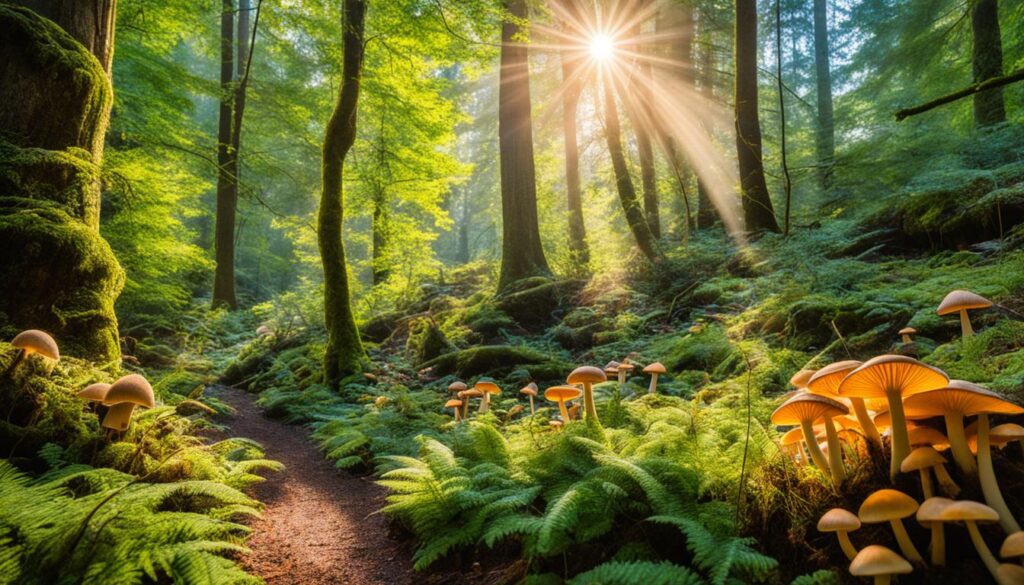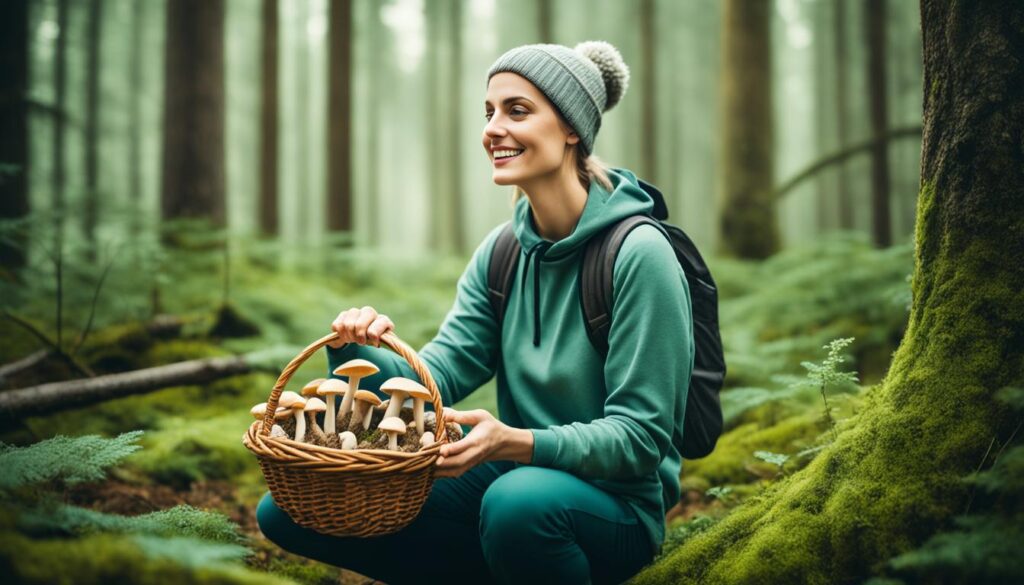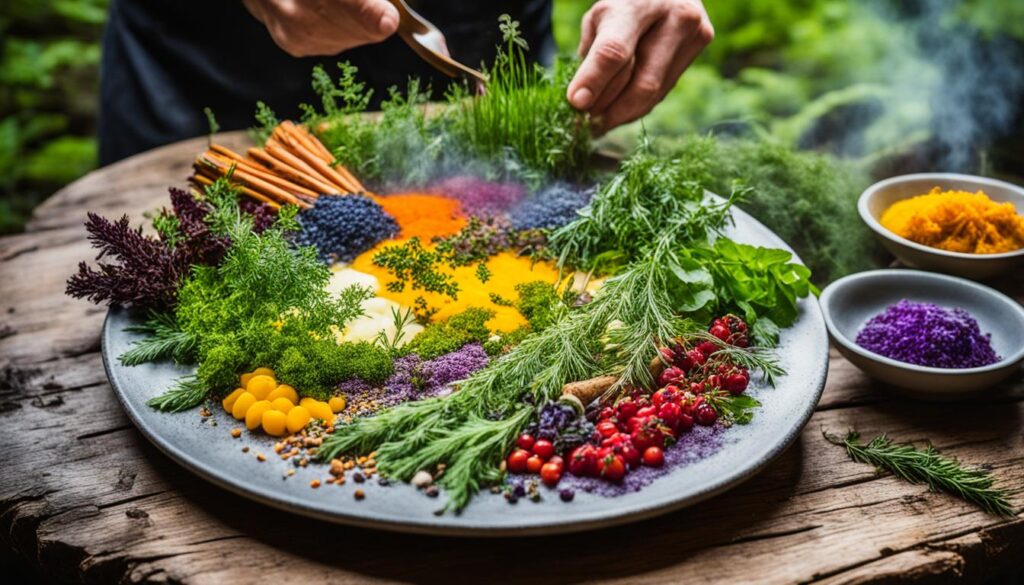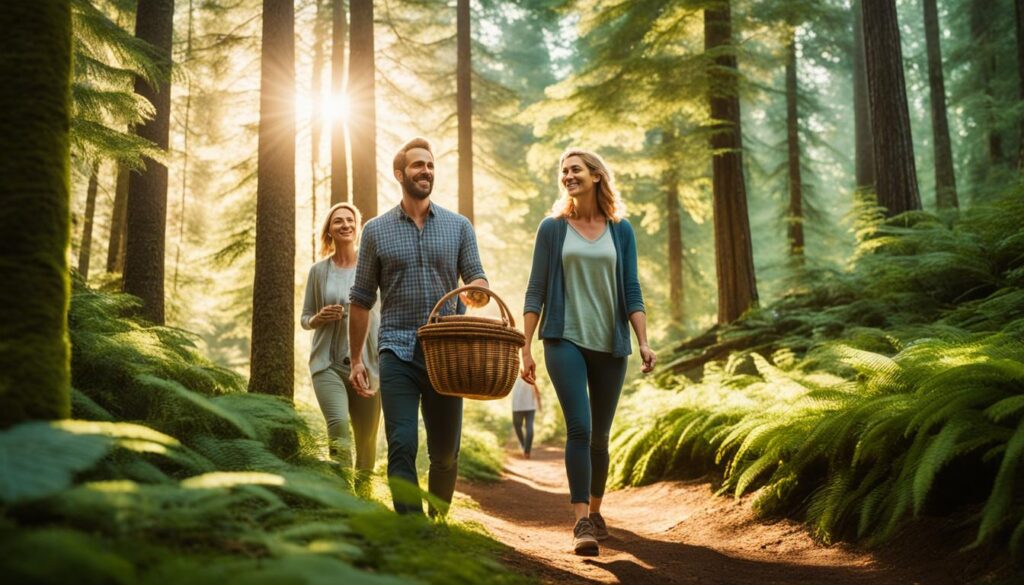Welcome to the world of luxury foraging, where the thrill of the wild meets the sophistication of gourmet cooking. Join me on an extraordinary journey as we explore the untamed landscapes in search of high-end ingredients that will elevate your culinary creations to new heights.
Imagine the excitement of venturing into nature’s pantry, discovering wild treasures that have been sought after for centuries by passionate chefs and food enthusiasts. From exquisite mushrooms and rare herbs to succulent berries and delicate edible flowers, the possibilities are endless.
In this article, we will delve into the rise of foraging for luxury cuisine, the allure of wild edibles, and the profiles of renowned foraging experts. We will also uncover the hidden treasures that nature holds and explore the world of outdoor learning adventures. Additionally, we will discuss the importance of foraging ethics and sustainability, as well as the art of infusing wild flavors into gourmet dishes.
So, if you’re ready to embark on a culinary adventure like no other, join me as we discover the wonders of high-end foraging and unlock the secrets of wild ingredients.
Key Takeaways:
- Luxury foraging offers a unique and exhilarating way to source high-end ingredients for gourmet cooking.
- Foraging for luxury cuisine is a growing culinary trend that brings the forest to the table.
- Wild edibles have a gourmet appeal and can elevate the taste and presentation of your dishes.
- Renowned foraging experts like Pascal Baudar have revolutionized the way we approach foraged ingredients.
- Nature is a treasure trove of hidden ingredients waiting to be discovered through the art of foraging.
The Rise of Foraging for Luxury Cuisine
The culinary world is constantly evolving, and a new trend has emerged that combines fine dining with the natural world: foraging for luxury cuisine. This innovative approach to cooking brings the forest to the table, elevating the dining experience to new heights.
Modern Culinary Trend: From Forest to Table
Foraging for luxury cuisine is more than just a passing fad; it represents a shift in the way we approach food. Instead of relying solely on conventional agricultural sources, chefs and food enthusiasts are now venturing into the wild to discover unique ingredients that Mother Nature has to offer.
This modern culinary trend, often referred to as “forest-to-table,” emphasizes the use of wild edibles in gourmet cooking. It embraces the philosophy of sustainability and showcases the incredible flavors and textures that can be found in the natural world.
The Gourmet Appeal of Wild Edibles
What makes foraged ingredients so special? It’s the undeniable gourmet appeal they bring to the table. From delicate, aromatic herbs to earthy mushrooms and vibrant edible flowers, wild edibles add a touch of elegance and sophistication to any dish.
Foraging for luxury cuisine allows chefs and home cooks alike to experiment with new flavors and create truly unique culinary experiences. By incorporating wild ingredients into their recipes, they can showcase their creativity and passion for gastronomy.
Profile of a Foraging Maestro: Pascal Baudar’s Epicurean Adventure
One notable figure in the world of foraging for luxury cuisine is Pascal Baudar. Known as a foraging maestro, Baudar has dedicated his life to exploring the wilderness in search of exceptional ingredients.
“Foraging is not just about sourcing ingredients; it’s about reconnecting with nature and understanding the beautiful balance it offers. It’s a journey of exploration and discovery that continually inspires me in the kitchen.”
Baudar’s epicurean adventures have taken him through forests, meadows, and coastlines, where he has unlocked the secrets of the wild and transformed them into culinary delights. His expertise and passion for foraging have positioned him as a leading authority in the field.
Join us in the next section as we unearth nature’s hidden treasures and delve deeper into the world of foraging for luxury cuisine.
Unearthing Nature’s Hidden Treasures
Embark on a journey of discovery as you uncover the hidden treasures that nature has to offer. Nature’s vast landscape is teeming with a diverse array of wild ingredients just waiting to be found. Through the art of foraging, you have the opportunity to explore and unearth these magnificent treasures.
Foraging, defined as the act of searching for wild food resources, is a thrilling and immersive exploration of the natural world. It allows you to connect with nature in a deeply meaningful way, as you navigate forests, fields, and coastlines in search of edible plants, mushrooms, and other wild delicacies. This foraging exploration takes you off the beaten path, allowing you to serendipitously encounter the bounties that nature has to offer.
One of the most exciting aspects of foraging is the discovery of wild ingredients. As you venture into the wilderness, you’ll stumble upon an abundant variety of plants and fungi that are not typically found in grocery stores or cultivated farms. These wild ingredients have unique flavors, textures, and aromas that are often unparalleled by their domesticated counterparts.
“Foraging allows you to rediscover the forgotten flavors of nature, awakening your senses to a whole new world of culinary possibilities.” – Foraging enthusiast
From pungent ramps and earthy morel mushrooms to delicate elderflowers and tangy wild berries, each wild ingredient adds a touch of mystery and excitement to your gastronomic pursuits. The process of gathering these wild treasures requires attentiveness, knowledge, and respect for the natural environment.
Foraging exploration is not only an opportunity to find hidden treasures but also a chance to deepen your understanding of the ecosystems that sustain us. It reinforces the importance of biodiversity and reminds us of the interconnectedness of all living beings. By engaging in sustainable foraging practices, you can help preserve these delicate ecosystems for future generations to enjoy.
So, embrace the spirit of exploration and set off on your own foraging adventures. Unearth nature’s hidden treasures and savor the wild ingredients that have been waiting patiently to be discovered.

Outdoor Learning Adventures: The New Gastronomic Movement
Experience the thrill of outdoor learning adventures, a unique and immersive way to engage with nature and gastronomy. This growing gastronomic movement combines the excitement of foraging with the educational benefits of experiential learning. Through outdoor education programs that blend gastronomy and nature, participants can discover the therapeutic benefits of nature-based culinary arts.
Foraging as Outdoor Experiential Learning
Foraging isn’t just about finding ingredients; it’s an opportunity to connect with the natural world, learn about ecosystem dynamics, and develop a deeper understanding of our environment. Engaging in outdoor experiential learning through foraging allows individuals to gain hands-on knowledge about local flora and fauna, foster a sense of curiosity, and develop a profound appreciation for the bounty that nature provides.
Outdoor Education Programs Blending Gastronomy & Nature
Outdoor education programs that blend gastronomy and nature offer a wide range of opportunities for individuals of all ages to explore the intersection of food and the natural world. These programs often include activities such as guided foraging walks, cooking workshops using foraged ingredients, and farm-to-table dining experiences. Participants can learn from expert foragers, renowned chefs, and environmental educators, gaining insight into sustainable practices and developing a holistic understanding of the food system.
The Therapeutic Benefits of Nature-Based Culinary Arts
Engaging in nature-based culinary arts, such as foraging, can have profound therapeutic benefits for both mental and physical well-being. Connecting with nature has been shown to reduce stress, improve mood, and increase creativity. When combined with the sensory experience of preparing and enjoying wild ingredients, the therapeutic benefits are further enhanced. Outdoor learning adventures provide a unique opportunity to tap into the healing power of nature while indulging in the delights of gastronomy.
| Outdoor Learning Adventures | Gastronomic Movement | Experiential Learning | Outdoor Education Programs | Therapeutic Benefits |
|---|---|---|---|---|
| Immersive and interactive experiences | Incorporates food and nature | Hands-on learning in natural settings | Blends gastronomy with environmental education | Reduces stress and improves well-being |
| Connects with the natural world | Explores the relationship between food and the environment | Develops a deeper understanding of ecosystems | Guided foraging walks and cooking workshops | Enhances creativity and mood |
| Fosters curiosity and appreciation for nature | Highlights sustainable practices | Engages with local flora and fauna | Farm-to-table dining experiences | Promotes mindfulness and relaxation |
Foraging Ethics and Sustainability
When engaging in the practice of foraging, it is crucial to consider the ethics and sustainability of our actions. Responsible harvesting practices not only ensure the long-term survival of wild ingredients but also contribute to the preservation of our environment and ecological balance.
Foraging ethics encompass a set of guidelines that help us make conscious choices while gathering wild edibles. These guidelines include:
- Respect for Nature: Cultivating a deep appreciation for the environment and understanding the interconnectedness of all living organisms.
- Selective Harvesting: Only taking what we need and leaving behind enough for the ecosystem to regenerate and thrive.
- Species Preservation: Identifying and protecting endangered or rare plants to maintain their population and biodiversity.
- Responsible Foraging Practices: Being aware of and adhering to local regulations, restrictions, and permits to ensure sustainable foraging.
- Educating Others: Sharing knowledge and raising awareness about foraging ethics to promote responsible practices and sustainable harvesting.
Embracing sustainable foraging means understanding the impact of our actions on the environment and making choices that minimize harm. By practicing sustainable foraging, we contribute to the protection of natural habitats and the preservation of delicate ecosystems.
It is essential to avoid over-harvesting and ensure that the plants and fungi we collect have a chance to propagate and regenerate. By doing so, we allow future generations to enjoy the luxury of foraging and continue the tradition of using wild ingredients in gourmet cooking.
Ultimately, foraging ethics and sustainability go hand in hand. By adopting responsible harvesting practices and educating ourselves about the ecosystems we interact with, we can uphold the integrity of foraging as a truly sustainable and enriching culinary experience.

Merging Tradition with Modern Cooking Techniques
When it comes to culinary innovation, tradition and modernity can coexist harmoniously. By merging age-old cooking techniques with contemporary methods, chefs have created a new wave of fusion cuisine that tantalizes the taste buds with innovative flavors and textures.
One of the most exciting aspects of this culinary movement is the incorporation of traditional foraged ingredients into modern recipes. By combining the wealth of knowledge passed down through generations with cutting-edge cooking techniques, chefs are able to unlock the full potential of these natural treasures.
“Fusion cuisine allows us to pay homage to the past while embracing the possibilities of the future. By blending tradition with innovation, we can create culinary masterpieces that carry the essence of our culinary heritage,” says Chef Karen Martinez, a trailblazer in the world of fusion cuisine.
The art of merging tradition with modern cooking techniques goes beyond just combining flavors. It involves reimagining classic dishes by infusing them with a contemporary twist. Take, for example, the humble soup. By incorporating modern techniques such as sous vide or molecular gastronomy, chefs can elevate this traditional comfort food into a gastronomic masterpiece.
A fusion of tradition and modernity also extends to the presentation of dishes. Chefs are now exploring creative plating techniques that showcase the harmony between the old and the new. By carefully arranging ingredients on the plate and using artistic flair, they create visually stunning culinary creations that are a feast for the eyes as well as the palate.
The integration of tradition and modernity in cooking has not only revolutionized the culinary world but also opened up new possibilities for experimentation. Chefs are constantly pushing the boundaries, combining unexpected flavors and textures to create innovative recipes that surprise and delight diners.
Through the art of merging tradition with modern cooking techniques, fusion cuisine has become a celebration of both the past and the present. It allows us to savor the richness of our culinary traditions while embracing the creativity and innovation of the modern culinary world.
The Art of Infusing Wild Flavors in Gourmet Dishes
Creative Cooking with Foraged Finds
When it comes to creative cooking, infusing wild flavors into gourmet dishes is an absolute game-changer. By incorporating foraged ingredients, you can elevate your culinary creations to new heights, surprising your palate and delighting your guests with unique and unexpected flavors.
To get started, begin by exploring your local wilderness, whether it’s a nearby forest, meadow, or even your own backyard. Take the time to learn about the wild plants, mushrooms, and other treasures that can be found in these natural spaces. Experiment with incorporating these foraged finds into your everyday dishes, allowing their distinct flavors to infuse and enhance your meals. It’s a wonderful way to connect with nature and truly understand the impact that wild ingredients can have on your cooking.

As you dive deeper into the world of creative cooking with foraged finds, you’ll discover a wide variety of wild herbs and spices that can take your dishes to the next level. From earthy mushrooms and aromatic garlic-scented ramps to vibrant wild berries and fragrant juniper berries, the possibilities are endless. These wild herbs and spices bring an incredible depth of flavor to your recipes, infusing a touch of wild luxury into every bite.
A Taste of Wild Luxury: Crafting Michelin-worthy Plates
For those who are truly adventurous in the kitchen, crafting Michelin-worthy plates using foraged ingredients is the ultimate pursuit. Michelin-starred chefs around the world have embraced the art of infusing wild flavors into their gourmet dishes, creating culinary experiences that are both indulgent and unforgettable.
When crafting Michelin-worthy plates, attention to detail is key. Each ingredient must be carefully selected and harmoniously combined to create a symphony of flavors. From delicate wild greens and edible flowers to succulent game meats and perfectly roasted wild mushrooms, every element plays a crucial role in achieving culinary excellence.
With the luxury of foraged ingredients at your disposal, you have the power to transform a simple dish into an extraordinary masterpiece. Whether you’re preparing a wild herb-crusted venison loin or a foraged mushroom risotto, the infusion of wild flavors will elevate your creation to new heights, promising a dining experience that is truly unforgettable.
Global Foraging Expeditions
Embark on a culinary adventure like no other with global foraging expeditions that will ignite your senses and tantalize your taste buds. These extraordinary expeditions offer the opportunity to explore untamed settings alongside world-renowned Michelin-starred chefs. Prepare to be amazed as you trailblaze through uncharted territories, discovering the hidden treasures of nature.
Trailblazing with Michelin-starred Chefs in Untamed Settings
Imagine trekking through pristine forests or scaling rugged mountains with a Michelin-starred chef by your side. These global foraging expeditions bring together the expertise of renowned culinary masters and the raw beauty of untouched landscapes. As you venture into the wild, you’ll learn firsthand from these culinary geniuses, uncovering their secrets for incorporating wild ingredients into extraordinary dishes.
Whether you’re harvesting edible mushrooms, foraging for wild herbs and spices, or seeking out unique plant species, you’ll witness the culinary creativity of Michelin-starred chefs as they transform nature’s bounty into gastronomic masterpieces. These immersive experiences provide a rare opportunity to witness the magic of culinary exploration in its purest form.
Gordon Ramsay’s Foraging Adventures: A Culinary Exploration
No discussion of global foraging expeditions would be complete without mentioning the legendary Gordon Ramsay. Known for his relentless pursuit of culinary excellence, Ramsay has embarked on numerous foraging adventures that have taken him to the depths of forests, the shores of remote islands, and the heart of vibrant markets.
Ramsay’s foraging expeditions are more than just a search for ingredients – they are a culinary exploration that pushes the boundaries of flavor. From gathering edible seaweed on the rocky coasts of Scotland to discovering the finest saffron in Morocco’s Atlas Mountains, Ramsay’s foraging escapades have allowed him to delve into the heart of local cuisines and bring new inspiration to his culinary creations.
Foraging Luxury in Morocco’s Wild Landscapes
One destination that stands out among the world’s wild landscapes is Morocco. With its diverse ecosystems and rich culinary traditions, Morocco offers a feast for both the eyes and the palate. Imagine traversing the sweeping dunes of the Sahara Desert, venturing into the lush valleys of the Atlas Mountains, and exploring the bustling markets of Marrakech, all in search of unique wild ingredients.
In Morocco’s wild landscapes, you’ll discover an array of aromatic herbs and spices, exotic fruits, and rare plant species. Experience the luxury of foraging amid breathtaking scenery, immersing yourself in the rich culture and history of this enchanting country. From traditional tagines infused with local wild herbs to delicate pastries bursting with flavors from foraged fruits, Morocco’s wild ingredients will transport you to a world of culinary delight.
Embarking on global foraging expeditions with Michelin-starred chefs and exploring Morocco’s wild landscapes is an experience that pushes the boundaries of culinary exploration. It is an opportunity to step outside the confines of traditional ingredients and embrace the thrill of foraging for the extraordinary. Get ready to embark on a journey that will forever change the way you see and taste the world.
Immersive Foraging Workshops and Retreats
Immerse yourself in the world of foraging with our immersive workshops and retreats. Experience the thrill of hands-on learning as you gain practical knowledge about foraging for wild ingredients. Our expert foragers will guide you through the natural landscapes, teaching you how to identify and responsibly harvest edible plants, mushrooms, and herbs.
During our immersive foraging workshops, you’ll have the opportunity to connect with nature on a deeper level, exploring the diverse ecosystems and foraging hotspots. Learn about the seasons and habitats that are ideal for different types of foraged ingredients. Discover the best practices for sustainable foraging and how to make a positive impact on the environment.
“Foraging workshops and retreats provide a unique opportunity to learn directly from nature and expert foragers. It’s a chance to develop a deeper understanding of the natural world and the incredible wealth of edible ingredients it offers.”
Our hands-on foraging experiences go beyond theoretical knowledge. You’ll have the chance to taste and gather wild ingredients, discovering their flavors and textures firsthand. From fields of vibrant wildflowers to lush forests filled with medicinal herbs, each foraging adventure is a sensory journey that engages all your senses.
By participating in our immersive foraging workshops and retreats, you’ll gain the confidence and skills to incorporate wild ingredients into your culinary creations. Whether you’re a professional chef looking to expand your repertoire or a food enthusiast eager to explore new flavors, our programs cater to all levels of expertise.

Join us on a foraging retreat and unlock the secrets of nature’s pantry. You’ll forge a deeper connection with the environment, learn sustainable foraging practices, and be inspired by the beauty and abundance of wild ingredients. Begin your journey into the world of foraging and experience the magic of discovering nature’s edible treasures.
Assembling a Wild Food Kitchen Arsenal
I’m excited to share with you the essentials for creating your very own wild food kitchen arsenal. With the right foraging tools and proper wild ingredient storage, you’ll be well-equipped to enhance your culinary creations with the flavors of the wild. Let’s dive in!
When it comes to foraging for wild ingredients, having the right tools in your arsenal is crucial. Here are some must-have items that will make your foraging adventures more successful:
- Foraging knife: A sharp, sturdy knife is essential for harvesting wild edibles. Look for a knife with a durable blade and a comfortable handle for ease of use.
- Basket or bag: A spacious basket or bag is necessary for collecting your foraged treasures. Opt for something lightweight and breathable to keep your ingredients fresh.
- Field guide: A comprehensive field guide will help you identify different plants, mushrooms, and other wild edibles in your foraging expeditions. Look for a guide specifically tailored to the region you’ll be foraging in.
- Gloves: Protect your hands from thorns, prickly plants, and other hazards with a good pair of gloves. Choose gloves that provide both comfort and dexterity.
- Berry picker: If you plan on foraging for berries, a berry picker can be a useful tool. This handheld device allows you to easily collect berries without damaging the plants.
To ensure the longevity and freshness of your wild ingredients, proper storage is key. Here are some best practices for storing and preserving your foraged finds:
- Label and date: It’s important to label and date your foraged ingredients to keep track of their freshness. Use waterproof labels and store them in a cool, dry place.
- Airtight containers: Invest in airtight containers, such as glass jars or plastic containers, to store your foraged ingredients. This will help prevent moisture and air exposure, keeping them fresh for longer.
- Freezing: Some wild ingredients can be frozen to extend their shelf life. Properly clean and prepare the ingredients before freezing them in labeled freezer bags or containers.
- Drying: Drying is another effective preservation method for wild ingredients. Hang herbs or use a dehydrator to remove moisture, then store them in airtight containers.
By assembling a wild food kitchen arsenal and following proper storage techniques, you’ll have access to a world of unique flavors and culinary possibilities. So get equipped, start foraging, and let nature’s bounty inspire your cooking!
Conclusion
In conclusion, the exploration of luxury foraging for gourmet cooking is a remarkable and enriching experience. Throughout this article, we have delved into the rise of foraging for luxury cuisine, unearthing nature’s hidden treasures, and the therapeutic benefits of nature-based culinary arts. We have also discussed the importance of foraging ethics and sustainability, as well as the art of infusing wild flavors into gourmet dishes.
By merging tradition with modern cooking techniques, we can create innovative recipes that showcase the unique flavors of foraged ingredients. Global foraging expeditions offer the opportunity to trailblaze with Michelin-starred chefs and explore wild landscapes, such as Morocco, where luxury foraging is possible.
Immersive foraging workshops and retreats provide hands-on experiences and the chance to connect with expert foragers. Assembling a wild food kitchen arsenal equips us with the tools and knowledge necessary to store and preserve wild ingredients effectively.
In summary, foraging for luxury cuisine offers endless possibilities for culinary exploration, while also promoting a deeper connection with the natural world. Whether it’s the thrill of discovering hidden treasures, the satisfaction of creating Michelin-worthy dishes, or the joy of learning and sharing with others, foraging for gourmet cooking embodies the essence of luxury and truly elevates the culinary experience.
